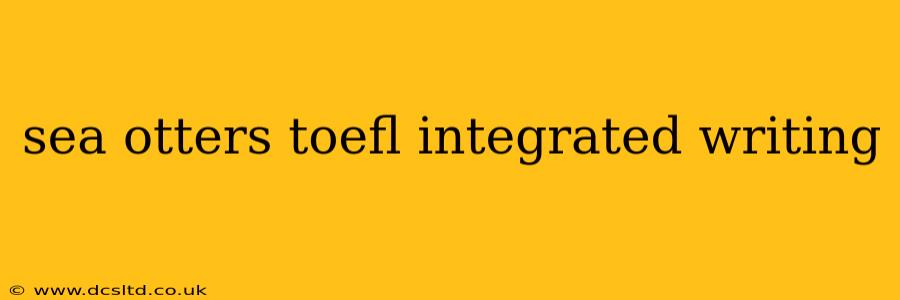Sea Otters: A TOEFL Integrated Writing Masterclass
The TOEFL Integrated Writing section tests your ability to synthesize information from different sources. A common topic involves analyzing a lecture that expands upon or contradicts a reading passage. Let's explore a hypothetical example focusing on sea otters, a popular subject for this section of the exam.
Hypothetical Reading Passage:
The reading passage might discuss the vital role sea otters play in maintaining the health of kelp forests. It could highlight how sea otters, as apex predators, control the populations of sea urchins, which are voracious kelp consumers. A decline in sea otter populations could lead to an increase in sea urchins, resulting in the devastation of kelp forests and the subsequent loss of biodiversity in the ecosystem. The passage may also mention the historical impact of human activities, like hunting, on sea otter populations and the ongoing conservation efforts to protect them.
Hypothetical Lecture:
The subsequent lecture might challenge or expand on certain points from the reading. For example, the lecture could introduce additional factors affecting kelp forest health, such as climate change and pollution. It might also suggest that while sea otters are crucial, other factors, like water temperature and nutrient availability, play a more significant role in the overall health of kelp forests than previously thought. The lecture could further elaborate on the complexity of the sea otter's role, mentioning that while they control sea urchin populations, other predators might also contribute to this control. Finally, the lecture might offer an updated perspective on conservation efforts, highlighting new strategies and their effectiveness.
How to Tackle this TOEFL Integrated Writing Task:
The key to a high-scoring response lies in effectively summarizing both the reading and the lecture and then synthesizing the information to demonstrate a clear understanding of the relationship between the two. Here's a structured approach:
1. Summarize the Reading Passage:
Begin by concisely summarizing the main points of the reading passage. Focus on the central argument – in this case, the crucial role of sea otters in kelp forest health through sea urchin population control. Mention the supporting evidence and the overall conclusion presented in the reading.
2. Summarize the Lecture:
Next, summarize the main points of the lecture. This should include any points that support, contradict, or modify information presented in the reading. Specifically address how the lecture expands upon or challenges the reading's assertions.
3. Synthesize the Information:
This is the most crucial part. Here, you need to demonstrate your understanding of the relationship between the reading and the lecture. You might structure this section around points of agreement and disagreement. For instance:
- Points of Agreement: Both the reading and the lecture agree on the importance of sea otters to the ecosystem.
- Points of Disagreement/Expansion: While the reading emphasizes the sea otter's role as the primary regulator of sea urchins, the lecture introduces other factors like climate change and nutrient availability that also impact kelp forest health. The lecture may also discuss the effectiveness of recent conservation efforts.
4. Addressing Specific TOEFL Integrated Writing Questions (Examples based on potential "People Also Ask" questions):
How do sea otters affect the kelp forest ecosystem?
Sea otters are keystone species in kelp forest ecosystems. By controlling sea urchin populations, they prevent overgrazing of kelp, thus maintaining the biodiversity and structural integrity of the kelp forest. Without sea otters, sea urchin populations would explode, leading to kelp forest devastation.
What are the threats to sea otter populations?
Historically, hunting significantly reduced sea otter populations. Today, threats include pollution, entanglement in fishing gear, and disease. Climate change also indirectly affects them by altering their habitat and prey availability.
What conservation efforts are in place to protect sea otters?
Conservation efforts involve habitat protection, anti-poaching measures, and research into diseases affecting sea otter populations. Efforts are also made to mitigate human-related threats, such as reducing pollution and implementing fishing regulations.
What other factors besides sea otters influence kelp forest health?
While sea otters are crucial, other factors significantly impact kelp forest health. These include water temperature, nutrient availability, ocean acidification, and pollution. The interaction of all these factors determines the overall health of the kelp forest ecosystem.
Conclusion:
Successfully navigating a TOEFL Integrated Writing task involving sea otters (or any topic) requires a clear and concise summary of both the reading and lecture, followed by a thorough synthesis that highlights the relationship between the two. By structuring your response and addressing potential questions, you can present a well-organized and compelling argument demonstrating your analytical and writing skills. Remember to use clear transitions and precise language to showcase your mastery of the English language.
